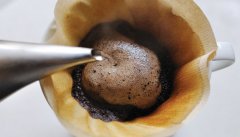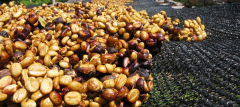Baristas must know that wet planing coffee is a must-drink gold manning
The wet planing method also allows beans to come into direct contact with the air because the seed shells are shaved off in the production process, and the chances of coffee beans being contaminated by molds and fungi are also greatly increased. Improper management and control in the production process may cause coffee beans to be boring or have a bad flavor, and defective beans such as moldy beans are much higher than the widely used methods of washing and tanning.
1. Peel the coffee fruit, put the shell beans into a vat or sink filled with water, and remove the defective shell beans floating on the liquid surface.
2. Wash the dense shell beans sunk to the bottom of the water slightly, put them into a bucket or plastic bag, and do a little dry body fermentation, that is, to ferment and flavor the pectin sugar on the surface of the seed shell. Basically, the longer the fermentation time, the more sour. Fermentation time varies from person to person, generally only a few hours, but there are manors omitting the dry body fermentation stage, direct exposure with shell beans, can always be sour and improve the sticky taste.
3. When the beans with shells are exposed to the sun for one or two days, the moisture content of the bean body is 30% 50%, and the bean body is still semi-hard and semi-soft. Wipe off the seed shell with a shell planer to speed up the drying process, and the moisture content is 12% 13% in about two days, which is about four days.
Wet planing is no less important to the global coffee industry than honey treatment. The "manning" that coffee people must drink is treated in this way, and it can even be said that the vast majority of Arabica coffee in Sumatra and Sulawesi in Indonesia are wet planed. Indonesia is the fourth largest coffee producer in the world, according to statistics from the international coffee organization ICO in 2014.

Important Notice :
前街咖啡 FrontStreet Coffee has moved to new addredd:
FrontStreet Coffee Address: 315,Donghua East Road,GuangZhou
Tel:020 38364473
- Prev

Play the three-stage style, stirring method, drip style and other hand flushing genres like a hand flush master.
The exchange of professional baristas please follow the coffee workshop (Wechat official account cafe_style) in the world of hand-brewing coffee, as much as possible to restore the flavor of beans, to taste well is the most important, and in order to achieve this goal, every step can be full of creativity, so there are many kinds of brewing methods, which is what we often call hand brewing genre. Several common techniques are: volcanic flushing and meteorites
- Next

Process and characteristics of wet planing treatment of raw coffee beans the surface of raw coffee beans in Manning looks moldy
Sumatran wet planing is the annual harvest season for manning in Sumatra from March to May and September to December, and now most coffee farmers only harvest all-red coffee cherries. After collecting coffee cherries in the morning, coffee cherries will be peeled and peeled in the afternoon. Sumatra has a superior natural environment, and most of the water used will be mountain spring water. 1. Peel the coffee fruit and place the peas with shells.
Related
- What is the meaning of lactic acid fermentation with coffee bean treatment?
- How to judge the state of foam by sound?
- How does the latte pull out the unicorn pattern? Come to get for a little trick to improve the flower pull!
- Will flower pulling affect the taste of the latte?
- Do you know the history of coffee?
- The difference between honey treatment and sun washing what is raisin honey treatment?
- What kind of milk can a novice use to make coffee foam to keep the foam longer? The correct method and skills of milking tutorial sharing
- Why do washed coffee beans taste sour? Flavor characteristics of washed Coffee
- Introduction to the skill of how to practice the size and height of water injection around the circle of hand-brewed coffee
- How do beginners practice coffee flower drawing from scratch?

